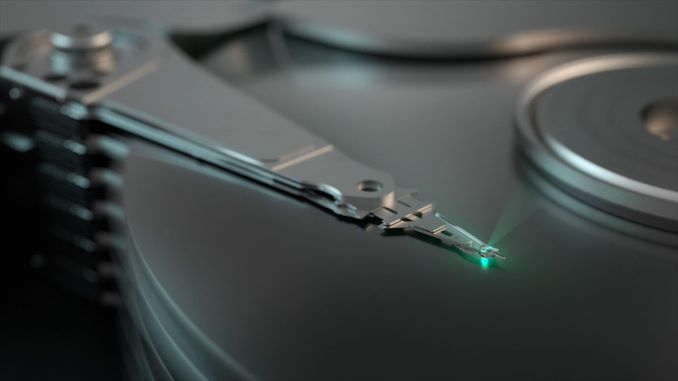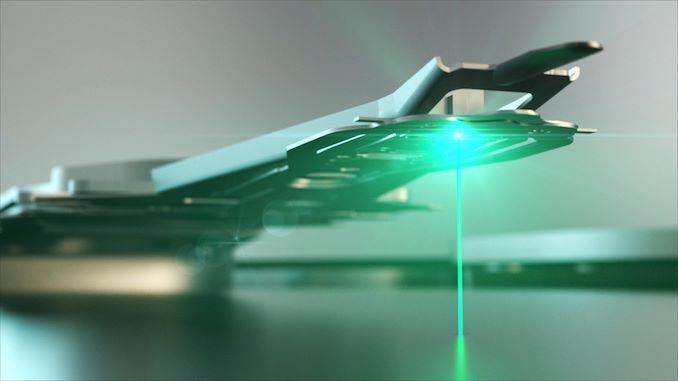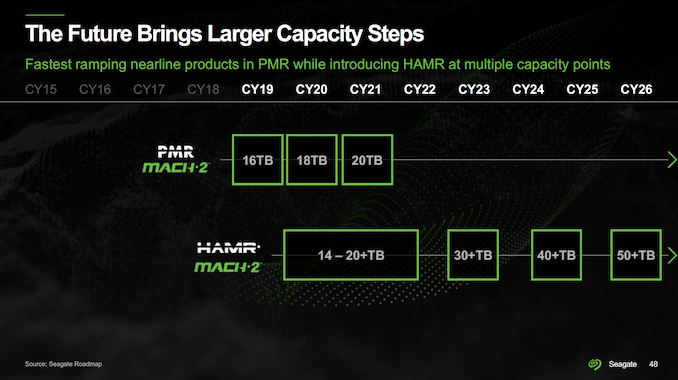Seagate Confirms 30TB+ HAMR HDDs in Q3, Envisions 50TB Drives in a Few Years
by Anton Shilov on January 27, 2023 6:00 PM EST
Seagate this week confirmed plans to launch the industry's first 30+ TB hard drive that uses its heat assisted magnetic recording (HAMR) technology, as well as reaffirming its commitment to release HDDs with capacities of 50 TB and higher in a few years. But before this happens, the company will release 22 TB and 24 TB HDDs that will rely on perpendicular magnetic recording (PMR) and shingled magnetic recording (SMR) technologies, respectively.
One More Play for PMR and SMR
Various energy assisted magnetic recording methods, such as HAMR, will be used for next generations of hard drives for years to come. But while PMR is running out of steam, it is still evolving. Seagate has managed to increase areal density enabled by its PMR + TDMR platform by around 10%, enabling 2.2 TB 3.5-inch HDD platters and thus 22 TB hard drives featuring 10 of such disks. Furthermore, by using shingled recording, these drives can have their capacity stretched to 24 TB.
These 22 TB and 24 TB Seagate Exos drives will likely be drop-in compatible with existing cloud datacenter hardware as well as infrastructure, and should not require extensive validation and certification procedures, unlike brand-new HAMR HDDs. As a result, Seagate's customers will be able to deploy such hard drives fairly quickly and increase storage density and storage capacity of their datacenters.
Seagate is now ramping up production of its 22 TB hard drives for datacenters, so expect the company to start their shipments shortly. Seagate is not disclosing when exactly it will officially launch its 22 TB and 24 TB parts, but we would expect them to arrive before the company introduces its HAMR-based HDDs; so think Q1 or Q2.
30+ TB HDDs Coming in Q3
In fact, Seagate has been shipping HAMR HDDs to select customers for evaluation as well as inside its own Lyve storage systems for a while, but those drives featured capacities akin to those of PMR/CMR HDDs and were not available in huge volumes. With Seagate's 2nd generation HAMR platform, the company is going after higher volumes, but it took the company quite some time to get there. The first pre-qualification high-capacity HAMR-based HDDs are only just now getting ready to head out to customers for evaluation.
"We are meeting or exceeding all product development milestones and reliability metrics, and we will be shipping pre-qualification units to key cloud customers in the coming weeks," said Dave Mosley, chief executive of Seagate.
Meanwhile, commercial HAMR hard drives with capacities of 30TB or higher will ship in third quarter of this year, which is in-line with what Seagate promised last year.
"As a result of this progress, we now expect to launch our 30-plus terabyte platform in the June quarter, slightly ahead of schedule," said Mosley. "The speed of the initial HAMR volume ramp will depend on a number of factors, including product yields and customer qualification timelines."
Initially Seagate will only offer its HAMR technology for its highest-capacity offerings for hyperscale datacenters, whom need maximum storage density and are willing to pay premium for the drives and for supporting infrastructure. As yields of HAMR-supporting media and the appropriate read/write heads increase, the technology will be applied for drives with lower capacities in a bid to cut down their production costs (fewer disks and heads, lower the costs). This is not going to happen overnight though, as the company needs to increase yields of HAMR drive components and the HDDs themselves to a comfortable level.
"I think this year, [the volume of HAMR HDDs] will probably still be relatively low," said the head of Seagate. "Then the faster we can get the yields and scrap and all the costs that we can control down on the heads and media, then the faster we'll be accelerating. I think that will happen in calendar year 2024 and calendar year 2025 will just continue to accelerate. The highest capacity points will be addressed, but also these midrange capacity points."
50+ TB HDDs Will Be Here in a Few Years
Seagate's launch of its first mass market 30+ TB HAMR hard drives platform will mark a milestone for the company and the whole industry. But apparently the company has another breakthrough to share at this time. The firm said this week that it had created 5 TB platters for 3.5-inch hard drives, which presumably entails new media, new write heads, and new read heads.
"It was nearly four years ago to the day that I first shared our lab results demonstrating 3 TB per disk capacities," explained Mosley. "And today, we have demonstrated capacities of 5 TB per disk in our recording physics labs."
For now, these platters are used on spinstands for evaluation and testing purposes, but platters like these will allow for 50 TB HDDs a few years down the line. Seagate's roadmap indicates that such hard drives will hit the market sometimes in calendar 2026.
It is unclear how thin the new platters are. But following current trends of nearline HDD evolution — increasing areal density and increasing number of platters per hard drive — it's not outside the realm of possibility that Seagate will find ways to integrate even more than 10 platters in future drives. In which case Seagate would be able to hit drive sizes even larger than 50 TB.
In any case, with ~3 TB platters in production, samples of ~30 TB HDDs shipping to customers, and 5 TB platters demonstrated in the lab, Seagate's HAMR roadmap seems to look quite solid. Therefore, expect hard drives to gain capacities rapidly in the coming years.












70 Comments
View All Comments
Samus - Monday, January 30, 2023 - link
Ultratech, you need to school yourself on some tech. Or at least tour a data center. Ask Cogent or AWS what their storage deployment strategy is now and for the near term: hard disks reign supreme for a variety of reasons other than cost.Silver5urfer - Tuesday, January 31, 2023 - link
They are coming. WD is also innovating with their plans esp their OptiNAND technology started high density CMR. They already debuted the Dual Actuator in Ultrastar series it's not your consumer class but pure Enterprise.There's a high demand of Storage even if HDD adoption rate is slowing and falling on all sectors, the archival is very important and since Optane is dead and the Enterprise TLC Is insanely low density vs HDD and garbage Endurance.
And also PCIe4.0 was here since 2020 on consumer space and the storage space is literally pathetic at 2TB max for majority and only 4TB exists in niche and 8TB in even insane expensive BS TLC tech which has horrendous TBW Endurance, only 4TB Firecuda is worth purchasing. And NVMe SAS / U.2 Enterprise SSDs are not even high density they have piss poor capacity.
PCIe 5.0 NVMe SSDs are not even here, not in Enterprise not in Consumer side. Only select Enterprise may have it already, and on Client / Consumer side 2TB is going to be a lot of cash for pathetic heat and low endurance. WD Gold 20TB can be bought for $400.
In the SATA SSD space, pathetic 4TB is the last option Samsung will soon retire 860 Evo and will kill high capacity NAND, ever seen how it looks inside ? 90% is free space lol a small chip. They could have made it 50TB easily but they did not because of greed and stupid consumers.
HDDs are never going away and if that is not the case WD would have put a ton of money on EAMR technologies and their new OptiNAND + Ultra SMR with extreme high densities and same for Toshiba for MAMR, and Seagate for HAMR all are targeting 50TB. It will happen. The major issue is it should be available for Clients too. I hope it does. Tired of buying multiple drives for those 4K REMUX and tons of old shows, Scene ISO copies etc.
Squeaky'21 - Monday, March 6, 2023 - link
Good words Silver5urfer! That UltraStar of which you speak is not 100% only for enterprise, ya know! I have 3 of them (14TBs and an 18TB) in my home office PC and I can tell you they are fully compatible with a regular PC and work a treat! I do 4K vid editing so need all the space i can get. I now exclusively buy the GOLD versions which are the same as GOLD except they don't have a few of the 'settings' that will enable them to work with more compatibility on enterprise systems. UltraStar and GOLD are 99.9% identical drives so you can'y go wrong with either and they are the very best WD has to offer. I wouldn't but any other drive, only WD, only GOLD.Squeaky'21 - Monday, March 6, 2023 - link
Sorry, in my adjacent comment I meant to say UltraStar not GOLD here . . . "I now exclusively buy the GOLD versions which are the same as 'UltraStar' except they don't have a few of the 'settings' that will enable them to work with more compatibility on enterprise systems.jerem43 - Sunday, February 5, 2023 - link
Somewhat relevant, I picked up two 1TB WD Raptor 10K HDD 22 years ago and have been using them for long term storage ever since. The PC they're in has been running 24/7 most of the time (not accounting for upgrades and such), and these beasties have yet to show a bad sector. The first (consumer) SDD I bought, A 128GB WD blue, failed recently after only a few years usage.This SSD was the boot drive and to extend its life I had offloaded the swap and temp files to a 3TB HDD to extend the life of the SDD. Even then, the SSD did fail.
Squeaky'21 - Saturday, March 4, 2023 - link
YEP! I concur Jerem43, those WD RAPTOR 10k rpm drives were the bomb back in the day!! I only buy WD and from here on they'll be WD GOLD and/or Ultrastar (same drive basically). Just wonderful and consummately reliable hard drives.yeeeeman - Monday, February 6, 2023 - link
Și they milked the heck out of SMR giving users 2tb each year. And now they finally move to hamr which gives 10tb each year. Good.albatrozz - Tuesday, February 7, 2023 - link
I'd love to own a 50TB drive, but unfortunately Seagate's reputation for reliability is... less than stellar.s.yu - Wednesday, February 8, 2023 - link
I concur...I no longer consider anything Seagate after a drive exhibited some data corruption soon after copied over from an old drive.Squeaky'21 - Saturday, March 4, 2023 - link
Like Jerem43 4 comments above, I have a 1TB WD Raptor 10,000rpm HDD and in two decades has never missed a beat. I also have 2x 4TB WD regular drives from that same period and they've been 100% reliable too. In fact, I was so impressed with them that 3 years ago I invested in 2x 14TB Ultrastar drives and in the last 2 years an 18TB GOLD and a 22TB Ultrastar. I do 4K vid editing so need the space. I have full confidence in WD drives, especially these new Ultrastar and GOLD (basically same drive). In fact, the new ones at 7,200 rpm wipe the floor with the Raptor 10,000rpm which was the superstar of HDDs back in the 2000s. I have never had a WD failure in my last 30 years but have had 4 Seagates die at the most inopportune times. Warranty was a hassle with 3 of them thanks to Seagate Australia and the other died just out of warranty. I sold my soul to WD back then and have been handsomely rewarded for my faith. These GOLD and Ultrastar drives truly are the best HDDs money can buy currently. Yes, my C:\ is a 2TB Samsung 980 NvMe. OS drive is the only exception I make in the HDD domain. Oh, and don't talk to me about SMR - I had a nasty laptop experience 4 years ago with Seagate I'd prefer not to discuss as swearing isn't kosher on this site ;-) . . . CMR all the way with me now as far as I'm concerned CMR is the ONLY HDD tech that should be sold to consumers at retail level.